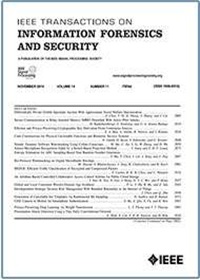The Capacity Region of Distributed Multi-User Secret Sharing Under Perfect Secrecy
IF 6.3
1区 计算机科学
Q1 COMPUTER SCIENCE, THEORY & METHODS
IEEE Transactions on Information Forensics and Security
Pub Date : 2024-10-23
DOI:10.1109/TIFS.2024.3484666
引用次数: 0
Abstract
We study the problem of distributed multi-user secret sharing (DMUSS), involving a main node, N storage nodes, and K users. Every user has access to the contents of a certain subset of storage nodes and wants to decode an independent secret message. With knowledge of K secret messages, the main node strategically places encoded shares in the storage nodes, ensuring two crucial conditions: (i) each user can recover its own secret message from the storage nodes that it has access to; (ii) each user is unable to acquire any information regarding the collection of完美保密条件下分布式多用户秘密共享的容量区域
我们研究的分布式多用户秘密共享(DMUSS)问题涉及一个主节点、N 个存储节点和 K 个用户。每个用户都能访问某个存储节点子集的内容,并希望解码一个独立的密文。在知道 K 个密文后,主节点会有策略地将编码共享放到存储节点中,以确保两个关键条件:(i) 每个用户都能从其可访问的存储节点中恢复自己的密文;(ii) 每个用户都无法获得有关所有其他用户的 $K-1$ 密文集合的任何信息。每个用户的速率定义为其秘密信息的大小与存储节点大小的归一化。我们描述了 DMUSS 问题的容量区域,即满足正确性和完全保密条件的所有可实现速率图元集合的闭合区域。反向证明依赖于传统的单秘密共享机制的约束。在可实现性证明中,我们首先设计了线性解码函数,其依据是每条秘密信息都需要从一组存储节点中恢复。结果表明,如果从解码函数中提取的 K 矩阵的条目是满级的,则完美保密条件成立。最后,我们通过求解线性解码函数系统得到了编码函数,其中一些份额等于随机性,另一些份额是密文和随机性的线性组合。
本文章由计算机程序翻译,如有差异,请以英文原文为准。
求助全文
约1分钟内获得全文
求助全文
来源期刊

IEEE Transactions on Information Forensics and Security
工程技术-工程:电子与电气
CiteScore
14.40
自引率
7.40%
发文量
234
审稿时长
6.5 months
期刊介绍:
The IEEE Transactions on Information Forensics and Security covers the sciences, technologies, and applications relating to information forensics, information security, biometrics, surveillance and systems applications that incorporate these features
 求助内容:
求助内容: 应助结果提醒方式:
应助结果提醒方式:


